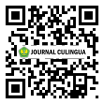THE VARIATION OF INDONESIAN ACRONYM FORMATION ON THE NEWSPAPERS IN NORTH SUMATERA
DOI:
https://doi.org/10.37301/culingua.v1i1.4Keywords:
acronym, principle-abiding, acronym pattern, acronym formationAbstract
This research contributes to the development of acronym formations in Indonesian that are in accordance with the patterns of acronym formation in newspapers in North Sumatra. The purpose of this study is to contribute to the acronym formation that are obedient to the pattern of acronym formations in Indonesian and how to overcome or find solutions to the problem of non-conformity in the process of acronym formations in Indonesian. This study uses the Research And Development Method (R & D). The research procedure is descriptive in nature with the steps as follow: 1) Potentials and problems: R & D departs from the problem of inconsistencies in the acronym formations in Indonesian, this is a potential and a problem. 2) Gathering Information: researchers collect information from various dailies published in North Sumatra and hold FGDs with Indonesian lecturers and teachers. The results show that there are acronym formations that do not adhere to the principles of Indonesian. The observation conducted by the researcher shows that daily events that occur in society contribute to the birth of these kinds of acronyms. Acronyms that do not obey the principles will lead to irregular Indonesian vocabulary and do not meet the requirements of a good language. The formulations of the problems in this research are: 1. What are the forms of acronyms that do not comply with the principles of newspapers in North Sumatra. 2. How are the forms of acronyms that do not comply with the principles of Acronym Formation in Indonesian. The results of this study found that several acronym formation processes in Indonesian are not aligned with the pattern of acronym formations in Indonesian.
References
Bauer, L. (1983). English Word Formation. Melbourne: Cambridge University Press.
Bauer, L (1988).Introducing Linguistic Morphology. Edinburgh: Edinburgh University Press.
Crystal, D. (1980). A Dictionary of Linguistics and Phonetics. New York: Cambridge University Press.
Dardjowidjojo, S. (2009). English Phonetics and Phonology for Indonesians. Jakarta: Yayasan Obor Indonesia.
Dardjowidjojo, S. (1985). Perkembangan Linguistik di Indonesia. Jakarta: Arcan.
Effendy, O. U. (2005). Ilmu Komunikasi Teori dan Praktek. Bandung: Remaja Rosda Karya.
Effendy, O. U. (2008). An Introduction to Morphology. R Sibarani. Medan: PODA, 2002.
Hartmann, et. a. (1973). Dictionary of Language and Linguistics. London: Applied Science Publishers.
Kridalaksana, H. (1996). Pembentukan Kata dalam Bahasa Indonesia. Jakarta: Gramedia Pustaka Utama.
Maulana, S. (1980). Glossary of Abbreviations and Acronyms Used in Indonesia. Jakarta: Ichtiar Baru bekerja sama dengan Van Hoeve.
Moeliono, A. M. (1990). Masalah Bahasa yang Dapat Anda Atasi Sendiri. Jakarta: Pustaka Sinar Harapan.
Moeliono, A. M. (1985). Ancangan Alternatif di dalam Perencanaan Bahasa. Jakarta: Djambatan.
Mulyana, D. (2000). Ilmu Komunikasi Suatu Pengantar. Bandung: PT Remaja Rosdakarya.
Plag, I. (2002). Word Formation in English. Ukraina: Cambridge University Press.
Putrayasa, Bagus, I. (2006). Tata Kalimat Bahasa Indonesia. Bandung: Refika Aditama.
Soehoet, H. (2003). Dasar Dasar Jurnalistik. Jakarta: Yayasan Kampus Tercinta, IISIP.
Sugiyono. (2012). Memahami Penelitian Kualitatif. Bandung: ALFABETA.
Sukmadinata, N. (2006). Metode Penelitian Pendidikan (2nd ed.). Bandung: PT.Remaja Rosdakarya.
Sumadiria, A. S. H. (2008). Jurnalistik Indonesia Menulis Berita dan Feature Panduan Praktis Jurnalis Profesional. Bandung: Simbiosa Rekatama Media.
Verhaar, J.W.M, et.al. (1996). Asas-asas Linguistik Umum. Yogyakarta: Gadjah Mada University Press.
Wibowo, W. (2001). Manajemen Bahasa. Jakarta: Gramedia Pustaka Utama.
Wibowo, W. (2010). Tata Permainan Bahasa Karya Tulis Ilmiah. Jakarta: Bumi Aksara.
Winarno, A. (1991). Kamus Singkatan dan Akronim Baru dan Lama. Yogyakarta: Kanisius.
Yasyin, S. (1997). Kamus Lengkap Bahasa Indonesia. Surabaya: Amanah.
Zahariev, M. (2004). Acronyms. Disertasi Bucharest: Simon Fraser University.
Zakaria, S. (1997). Kapita Selekta Bahasa Indonesia. Sumedang: HUP.
Downloads
Published
Issue
Section
License
Copyright (c) 2020 Susy Deliani, Sutikno, Sahril

This work is licensed under a Creative Commons Attribution 4.0 International License.









